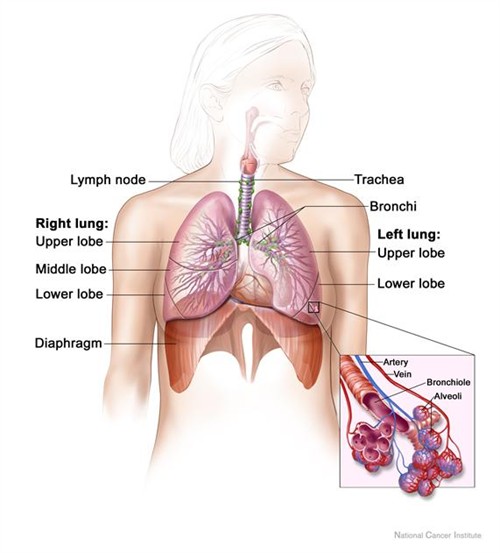Bhopal Disaster: A Tragic Environmental Pollution Case Study
By Irina Bright.
This article is part of our Environment section
See the complete list of all our Pollution Articles here.
Bhopal disaster that took place in 1984 in India presents one of the most tragic cases of environmental pollution ever.
 Environment is our precious treasure.
Environment is our precious treasure.Photo: Aaron Burden
There is absolutely no doubt that pollution has grown into a serious environmental issue as we know it because of its undeniably adverse impact on our whole planet.
Environmental pollution affects not only people, animals and vegetation but also the wider environment such as mountains, rocks, lakes, rivers and so on.
Perhaps one of the best ways to demonstrate the damaging effects brought about by all types of pollution is to examine a well-known case study and see how all those involved are affected from a practical perspective.
In this respect, we believe that the Bhopal disaster that took place in India in 1984 presents a suitable example for our purposes.
Bhopal Disaster: What Exactly Happened in Bhopal in 1984?
On the night of December 2 1984, a deadly dosage of the poisonous methyl isocyanate gas leaked from a tank of the pesticides plant in Bhopal owned by the US company Union Carbide.
Here is what happened next:
The gases swirled across the ground into nearby bustees (slums), killing Bhopal's poorest inhabitants in their sleep, burning the eyes and lungs of survivors, and causing nearly two decades of deaths, injuries and ill health. Estimates of the number of people killed on the first night range from an official figure of 3,000 to as many as 7,000 or 8,000 (partly based on the number of kafans, or shrouds, ordered by religious organisations for wrapping the dead). Since then, at least another 10,000 to 15,000 of those affected have died. (Ref. 1)
Since then the city of Bhopal has been called by some a "global toxic spot" and even a "Hiroshima of chemical disasters".
It is not the aim of this article to go into the causes of this horrendous environmental pollution accident. But we feel that John Elliott of the UK's New Statesman quite correctly named it to be "a deadly blend of big corporation hubris and managerial incompetence" that led to this tragedy. (Ref. 2)
Another salient point to remember is that many people put into question the official version that it was methyl isocyanate (MIC) that was leaked from the storage tank.
The reason for such doubts is this:
Doctors who performed autopsies in the first twenty-four hours found high levels of cyanide in blood and tissues in the most severe cases. The chemical reaction that took place in the tank could have produced hydrogen cyanide.
Union Carbide and the government did not pursue this explanation because cyanide had been used in German concentration camps in the Second World War, and discovery that this was the cause of the deaths would have led to a very strong adverse public reaction. (Ref. 3)
Knowing the exact nature of the gas would have made the doctors' work much more effective in the years that followed - since this would have, of course, allowed them to better determine short- and long-term medical strategies for treating the victims. (Ref. 4)
We will now try to summarize most environmental effects of the Bhopal disaster that have been documented by various publications.
Bhopal Disaster: Air Pollution Effects of Bhopal Gas Leakage
So what do we know about MIC (assuming that was the gas that leaked)? We know that MIC is an extremely toxic and reactive gas which should be handled with absolute caution. Here is what Ashok Bhargava reports (Ref. 5):
 Bhopal Disaster: Blind Woman as a result of environmental pollution in Bhopal.
Bhopal Disaster: Blind Woman as a result of environmental pollution in Bhopal.© Bbc.co.uk
The effects of [this] chemical on human beings resemble those of nerve gas. The eyes water, and the cornea is rendered opaque. Vomiting, racking coughs, and a sense of suffocation and temporary blindness are common. In larger amounts exposure can kill the cells of the cornea, producing permanent blindness.
It can also bring about emphysema, asthma, bronchitis, pneumonia, and other respiratory ailments.
Heavy exposure can cause death by suffocating spasms of the bronchial tubes carrying air to the lungs, or by drowning as body fluids released by the irritating gas accumulate in the lungs. Because of the danger of suffocation, the chances of ill effects increase if one runs when MIC is present in the atmosphere, as running increases the oxygen requirement. ...
[Long-term effects may be] lung, kidney, liver, and eye damage, because MIC destroys protein in the blood stream; the kidneys and liver become overworked trying to rid the body of these aberrant wastes. It can lead to keratitis and corneal ulcers which could cause opacity of the cornea.
Now let's see what air pollution effects had actually been reported in the days, months and years that followed the Bhopal environmental pollution tragedy.
Acute reactions to gas inhalation in the immediate wake of the Bhopal disaster's gas leakage (Ref. 6)
- Violent coughing
- Burning eyes
- Difficult breathing
- Death due to lungs being filled with fluid
- Death due to heart attacks
A medical survey conducted 100 days after the accident found that out of roughly 250,000 people who were exposed to the gas, more than 40,000 people had mild to moderate medical disability and more than 60,000 had severe medical disability. (Ref. 7)
Long-term air pollution-related health effects of the Bhopal disaster (Ref. 8)
Physiological effects.
- Adversely affected lungs
- Breathlessness
- Persistent cough
- Vomiting, diarrhea, and abdominal pain
- Burning and watering eyes and impaired vision
- Early-age cataracts
- Loss of appetite
- Recurrent fever
- Back and body aches
- General weakness
- Weakness of muscles and loss of coordination
- Loss of sensation in limbs
- Excessive vaginal discharge and irregular menstrual cycles
- Poor-tasting and diminished milk
Psychological effects.
- Anxiety
- Phobia
- Depression
- Panic
- Anger
- Nervousness
- Insomnia
- Fatigue
- Helplessness
- Hallucinations
Children-related effects (incl. effects on children born to mothers who inhaled the gas).
- Boys showing abnormalities such as small craniums and shorter heights
- Girls inheriting their mothers' menstrual problems
- Immune systems of both sexes are weakened
- Retarded growth of fetuses
- Miscarriages
- Abnormal babies
General environmental pollution effects of specific Air Pollutants.
Specific air pollutants we discuss below were found in high concentrations in Bhopal's contaminated areas as well. We list some health-related effects of these toxins which we know about from scientific studies on a variety of other pollution cases.
Mercury effects via inhalation - moderate to high levels of exposure.
 Bhopal Disaster: Mercury & other air pollutants have negative effects on lungs & respiratory system.
Bhopal Disaster: Mercury & other air pollutants have negative effects on lungs & respiratory system.Via Wikimedia.org
- Vomiting, nausea & diarrhea
- Increased blood pressure
- Increased heart rate
- Skin & eye irritation
- Respiratory distress
- Pulmonary edema
- Corrosive bronchitis & pneumonitis
- Damage to the kidneys
- Damage to the central nervous system
- Tremors & spasms
- Loss of memory, depression
- Extreme excitability, personality changes
- Inflammation of the gums, metallic taste, mental instability, tremors (the "hatters' disease")
- Death from exposure to very high levels of elemental mercury vapor
Children-related effects - moderate to high levels of exposure to mercury.
- Dizziness
- Insomnia
- Peripheral neuropathy - numbness & tingling in hands and feet
- Tremors
- Irritability
Lead.
- Interference with the proper functioning of enzymes
- Anemia
- Shortening of the life of red blood cells
- Damage to the central nervous system
- Damage to the brain
- Kidney damage
- Atrophy of the renal tubules
- Bone disorders
- Gout
- Cardiovascular disease
- Probable human carcinogen
- Abdominal colic in metal worker attributed to lead exposure by Hippocrates in 370 BC
- Devonshire colic attributed to lead-contaminated cider in 1767
Children-related effects of lead pollution.
 Bhopal Disaster: Children are highly susceptible to air pollution from heavy metals.
Bhopal Disaster: Children are highly susceptible to air pollution from heavy metals.© Heather Buckley
- Biggest danger to children living in urban areas
- Miscarriages & stillbirths
- Possible reduced birth weight, pre-term delivery
- Possible birth defects
- The brain of the fetus highly sensitive to lead
- Impaired physical & mental development
- Decreased stature or growth
- Decreased ability to maintain a steady posture
- Colic
- Kidney damage, renal toxicity - aminoaciduria
- Possible kidney cancer & hypertension
- Impaired Vitamin D activation
- Anemia
- Neurological damage
- Peripheral neuropathy
- Reduced nerve conduction velocity
- Neurobehavioral & cognitive deficits
- Decreased intelligence
- Deficits in short-term memory, reading, spelling and reaction time
- Hearing deficits
- Ocular neuritis with paralysis of eye muscles
- Epilepsy
- Encephalopathy
- Delirium, convulsions, paralysis, coma & death at high lead concentrations
Cadmium effects via inhalation.
- Permanent or fatal lung damage
- Probable lung cancer
- Severe tracheobronchitis
- Pneumonitis
- Pulmonary oedema
- Emphysema - lung damage that causes breathlessness
- Dyspnoea - difficult breathing
- Respiratory injury in animals
And what about animals - how did they react to such overwhelming doses of pollution? It shouldn't be surprising to suggest that animals had suffered just as much as people.
Reports published several months after the Bhopal disaster's gas leak claim that as many as 2,000 commercial cows, buffaloes, goats and horses as well as thousands of stray dogs, cats and birds died immediately. (Ref. 9)
Vegetation surrounding the affected areas had also been badly affected. People were even warned about eating locally grown vegetables as many plants showed signs of genetic damage. (Ref. 10)
Further remarks.
We have just described the effects of only several airborne toxins which were found in high concentrations in Bhopal's affected areas. There are, of course, a lot more air pollutants - which exist as gases or as particles in the atmosphere. Virtually all of them have adverse effects on humans, animals as well as trees & vegetation.
Many of these Air Pollution Effects are just as serious as the ones experienced in Bhopal. We discuss the details in the article mentioned.
Bhopal Disaster: Water & Soil Pollution Effects of Bhopal Gas Leakage
While water & soil pollution - which still plague the site and surrounding areas of the Union Carbide plant in Bhopal - had not been a direct consequence of the 1984 gas leakage, it is hard not to think about it as an integral part of this pollution saga.
Here is what Jack Laurenson reports as of 2011 (Ref. 11):
Although it was the release of toxic gas that drew worldwide attention to Bhopal, Union Carbide had been openly dumping its highly toxic waste in the surrounding areas for years, and water and soil contaminated with chemicals and heavy metals continues to claim lives. Entire communities suffer with painful, debilitating illnesses. ...
Greenpeace and other organisations, including the CSE, have found high concentrations of chlorobenzenes and volatile and semi-volatile organochlorines, as well as metals such as chromium, copper, nickel, lead, zinc and mercury in the local water and soil.
Mercury concentrations seven million times higher than the World Health Organization's recommended limits have been recorded, and all of the water pumps in the area have been found to be heavily contaminated with toxins and metals.
There are reports that more than 350 tons of toxic waste are still scattered around the site and continue to pollute the soil and groundwater in the area which leads to cancer, congenital defects, immunity problems and many other conditions. (Ref. 12)
What is even more shocking is the fact that concentrations of some toxins continue to rise as they seep through the soil and straight into the groundwater. In spite of that, residents have to use their local groundwater supplies due to the lack of any better alternatives. (Ref. 13)
One of the most troubling effects of the Bhopal disaster's water and soil pollution in the affected area of Bhopal is of course the presence of high concentrations of poisons in the breast milk of lactating women (ref. 14), since this invariably implies long-term health problems for the breast-fed babies.
While we cannot list all the adverse effects of this specific case, we'll try to summarize common Effects of Heavy Metals Pollution of water and soil - of which we have general knowledge - and which we can reasonably expect to find in Bhopal as well.
Bhopal Disaster: General Effects of Heavy Metals Pollution Found In Water & Soil
Heavy metals pollution has been called "potentially one of the most serious forms of aquatic pollution" (ref. 15), and for a very good reason.
A study into the Bhopal disaster conducted by Greenpeace in 1999 identified a large number of toxic heavy metals still found in high concentrations at the Union Carbide factory site including soil & groundwater supplies.
Some of these heavy metals are: mercury, lead, cadmium, chromium, copper, nickel, zinc. (Ref. 16)
Most of them are present in the environment in different forms. We look at the effects of the harmful forms of these chemicals (ex., methyl mercury).
As we already mentioned above, these are common effects of these chemicals that we are aware of from scientific studies on a variety of other pollution cases.
So let's summarize health-related environmental pollution effects of the above-mentioned metals found in water and soil. (Ref. 17)
Mercury.
 Bhopal Disaster: Mercury damages central nervous system.
Bhopal Disaster: Mercury damages central nervous system.© Andrew Mason
- Serious damage to the central nervous system
- Brain damage
- Liver, kidney & pancreas damage
- Possible genetic damage
- Serious congenital disorders causing damage to the fetus and especially its brain
- Corrosion of the intestinal tract
- Nausea, diarrhea
It is important to note that mercury, alongside other pollutants, will continue to seep through contaminated soils into groundwater aquifers for many years to come. And this makes it even harder for those responsible to alleviate effects of mercury environmental pollution on the affected populations.
An extreme case of mercury water pollution - Minamata Disease:
- Serious brain damage
- Delirium
- Disturbance of gait
- Disturbance of speech, difficulty in articulating words
- Loss of hearing and sight
- Numbness of extremities
- Paralysis
Children-related effects of mercury pollution.
High-level prenatal exposure to mercury mostly through food & drink (shown to be present both in young animals and humans):
- Cerebral palsy
- Microcephaly
- Cerebellar ataxia
- Seizures
- Primitive reflexes
- Blindness
- Mental retardation
- Dysarthria (speech disorder)
- Major cognitive deficits
Low-level pre-natal exposure mostly through food & drink (shown in animals but can be reasonably expected to be present in young humans as well).
- Visual memory deficits
- Abnormal social behavior
- Reduced growth at puberty
Other symptoms of pre- and post- natal exposure to mercury environmental pollution:
- Peripheral neuropathy
- Involuntary movements
- Renal failure with nephrosis & necrosis of proximal tubules
- Possible renal tubular damage
- Possible occurrences of cancer
- Acrodynia - mercury poisoning disease -was caused by use of inorganic mercury (mercurous chloride) in teething powders at the start of the 20th century, with the following symptoms:
- irritability
- stomatitis
- insomnia
- erythema - redness - of hands, feet and other areas
Lead.
When found in water & soil, lead causes the same adverse effects as when found in the air. Please see lead air pollution effects here.
Cadmium.
- Ingested cadmium has a very long half-life of 16 - 33 years in the human body
- Damage to the liver & kidneys
- Renal tubular cell injury
- Leukemia
- Testicular tumors
- Proliferative prostatic lesions
- Hypertension
- Heart disease
- Adverse neurobehavioral effects on rodents
- Stunted plant growth & reduced yields
- Reductions in plants' rates of photosynthesis & transpiration
An extreme cadmium environmental pollution case - Itai-Itai Disease (meaning Ouch-Ouch)
- Severe pain in the back, joints and lower abdomen
- Waddling or duck-like gait
- Loss of calcium from the bones
- Osteomalacia - softening of the bones
- Osteoporosis - reduction of the bone mineral density
- Multiple bone fractures
- Kidney lesions
- Proteinuria
- Glycosuira
Further remarks.
This chapter has dealt mostly with some health-related environmental pollution effects of several heavy metals found in water & soil. To give you a better understanding of this topic, we look at general Pollution Effects - including air, water & soil pollution - on humans, animals and plants in more detail here.
Bhopal Disaster: 28 Years On
Many years down the road after the Bhopal disaster in 1984, some basic clean-up efforts had taken place but a lot of the contamination is still there. The local people have to live with this environmental pollution every single day.
While the Bhopal disaster has certainly received a lot of international attention, not much progress has been achieved to improve people's lives in the area.
Unfortunately, Dow Chemicals hasn't owned up to its responsibilities and continues to undermine the efforts of activists who try to bring justice to Bhopal's people.
Written by: Irina Bright
Original publication date: 2012
Republication date: 2020
References
1. Elliott, J. (March 25, 2002). Bhopal Refuses to Flip the Page: After More Than 17 Years, Thousands of Indians Still Suffer from the Lethal Gases That Leaked from a US Chemical Plant. New Statesman, 131. Retrieved December 23, 2011, from Questia.com
2. Ibid.
3. Bhargava, A. (1986). The Bhopal Incident and Union Carbide: Ramifications of an Industrial Accident. Bulletin of Concerned Asian Scholars, 18(4). Retrieved December 23, 2011, from Questia.com
4. Ibid.
5. Ibid.
6. Ibid.
7. Ibid.
8. References include:
a) Sarangi, S. (2002). Crimes of Bhopal and the Global Campaign for Justice. Social Justice, 29(3). Retrieved December 23, 2011, from Questia.com
b) Bhargava, A. (1986). The Bhopal Incident and Union Carbide: Ramifications of an Industrial Accident. Bulletin of Concerned Asian Scholars, 18(4). Retrieved December 23, 2011, from Questia.com
c) Elliott, J. (March 25, 2002). Bhopal Refuses to Flip the Page: After More Than 17 Years, Thousands of Indians Still Suffer from the Lethal Gases That Leaked from a US Chemical Plant. New Statesman, 131. Retrieved December 23, 2011, from Questia.com
d) Labunska, I., Stephenson, A., Brigden, K., Stringer, R., Santillo, D. & Johnston, P.A (November, 1999). The Bhopal Legacy. Toxic contaminants at the former Union Carbide factory site, Bhopal, India: 15 years after the Bhopal accident. Bhopal.net & Greenpeace. Technical Note 04/99. Retrieved December 23, 2011 from http://www.bhopal.net/oldsite/documentlibrary/bhopal.pdf (Mercury, lead & cadmium)
e) Laws, E. A. (2000). Aquatic Pollution: An Introductory Text. Wiley, New York, p. 383 (mercury), pp. 419 - 422 (lead), p. 404 (cadmium). Retrieved December 23, 2011 from Questia.com
f) Wigle, D. T. (2003). Child Health and The Environment. Oxford University Press, New York, pp. 113 - 114 (mercury), pp. 72 - 93 (lead). Retrieved December 23, 2011 from Questia.com
9. Bhargava, A. (1986). The Bhopal Incident and Union Carbide: Ramifications of an Industrial Accident. Bulletin of Concerned Asian Scholars, 18(4). Retrieved December 23, 2011, from Questia.com
10. Ibid.
11. Laurenson, J. (March, 2011). Bhopal's Toxic Legacy: Twenty-Six Years after the Release of a Huge Cloud of Toxic Gas from the Union Carbide Factory in Bhopal Killed Thousands of People and Affected Hundreds of Thousands More, Those Living in the Vicinity of the Abandoned Plant Continue to Die from Chronic Illnesses. Geographical, 83. Retrieved December 23, 2011, from Questia.com
12. Bhopal Water Still Toxic, 25 Years on Study Says. (December 1,2009). Manila Bulletin. Retrieved December 23, 2011, from Questia.com
13. Ibid.
14. Sarangi, S. (2002). Crimes of Bhopal and the Global Campaign for Justice. Social Justice, 29(3). Retrieved December 23, 2011, from Questia.com
15. Laws, E. A. (2000). Aquatic Pollution: An Introductory Text. Wiley, New York, p. 371. Retrieved December 23, 2011 from Questia.com
16. Labunska, I., Stephenson, A., Brigden, K., Stringer, R., Santillo, D. & Johnston, P.A (November, 1999). The Bhopal Legacy. Toxic contaminants at the former Union Carbide factory site, Bhopal, India: 15 years after the Bhopal accident. Bhopal.net & Greenpeace. Technical Note 04/99. Retrieved December 23, 2011 from http://www.bhopal.net/oldsite/documentlibrary/bhopal.pdf (Mercury, lead & cadmium)
17. References include:
a) Laws, E. A. (2000). Aquatic Pollution: An Introductory Text. Wiley, New York, pp. 383 - 397 (mercury), pp. 403 - 409, p. 228 (cadmium). Retrieved December 23, 2011 from Questia.com
b) Labunska, I., Stephenson, A., Brigden, K., Stringer, R., Santillo, D. & Johnston, P.A (November, 1999). The Bhopal Legacy. Toxic contaminants at the former Union Carbide factory site, Bhopal, India: 15 years after the Bhopal accident. Bhopal.net & Greenpeace. Technical Note 04/99. Retrieved December 23, 2011 from http://www.bhopal.net/oldsite/documentlibrary/bhopal.pdf (Mercury & cadmium)
c) Wigle, D. T. (2003). Child Health and The Environment. Oxford University Press, New York, pp. 103 - 116 (mercury), pp. 121 - 122 (cadmium). Retrieved December 23, 2011 from Questia.com